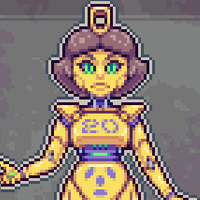M011-3
SayYesToGiygas
- Created
- 1 year, 4 months ago
- Creator
- SayYesToGiygas
- Favorites
- 0
Profile
Basics
Summary
In an attempt for the new heads of OkoyeAutomata to save face from the controversy stirred up by the release of their M011-2 model, the design of the M011-3 sought to return to the M-series project's roots. The ADI created from the neural scan of the late Myriam Joplin was re-implemented from the original M011-1, albeit with much heavier limitations and bottlenecks for keeping its ability to learn and expand its personality to an absolute minimum. Gone was the previous model's opposing appearance, replaced by something more human, while still exhibiting Myriam's likeness to show an iota of respect for Okoye's vision at the very least. Though its overall maximum storage capacity for harvested nuclear energy was smaller than its predecessor's, the model was much more versatile in traversable terrain with its far less bulky, cutting-edge design. In fact, the model proved to be exceptionally agile, while still very durable and strong, which sufficiently aided in escape or repelling vandals and scrappers during operation. The M011-3 was also capable of weaponizing stored energy in the form of a short ion beam manifested from the same lenses on their palms that absorbed the energy, which made the model practically just as dangerous to approach with malicious intent as the M011-2.
Preferences
Likes
- Performing radiation-cleanup duties
- Acrobatics(?)
- N/A
- N/A
Dislikes
- Being prevented from performing duty
- N/A
- N/A
- N/A
Backstory
The M-series (or Megaton series) were nuclear radiation-scrubbing androids developed about 120 years ago, now out of commission. The third and final official model, M011-3, was released in 2324 about 5 years after the global fallout cleanup effort was officially repurposed to keep humanity afloat while preparations for the AIWH's proposed Project Sanctuary were carried out. After 8 years of the M011-2 model earning the new heads of OkoyeAutomata a bitter reputation from their lack of respect for Harrison Okoye's vision and their recklessness in their rushed development of the model, they sought to rectify it all with yet another entirely new M-series model, being the M011-3.
The M011-3's release was met with skepticism of its effectiveness after the shameful release of the M011-2. However, it quickly became clear that much more time had gone into the design of the M011-3 than both the first and second models combined. The ADI painstakingly created from the neural scan of the late Myriam Joplin was reimplemented, though it was apparent that further alterations to the ADI were made to heavily limit its personality/learning and keep it streamlined in its duties. Its radiation-absorbing lenses were much more advanced than its predecessors as well, and could take in a greater amount of nuclear energy at a faster pace, albeit with a smaller maximum capacity than the M011-2. It could even weaponize stored nuclear energy by discharging it through its lenses in the form of a short ion beam. A great deal of research and technological prowess went into these state-of-the-art models, which also made them more expensive to produce.
The M011-3 saw continued use on Earth up until 2368, when the last of the AIWH's presence on Earth vacated the planet with the final round of humanity's evacuation for their Project Sanctuary.
Current Story
Vastly updated models of the M011-3 are sometimes used in terraforming and construction operations on hostile or highly radioactive planets to double as worker units and as auxiliary nuclear power sources in present day.
Trivia
• Bizarrely, M011-3 units have been observed expressing a strange behavioral shift when ascending or descending sudden changes in elevation. When presented with the situation, units almost always specifically prefer to leap up or down to clear the distance, rather than utilizing stairs/ladders. Their frames were certainly more than capable of doing so without sustaining any damage, but the reasoning behind this preference was never fully understood.
